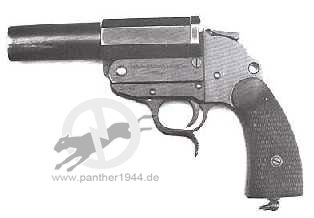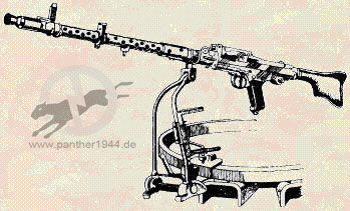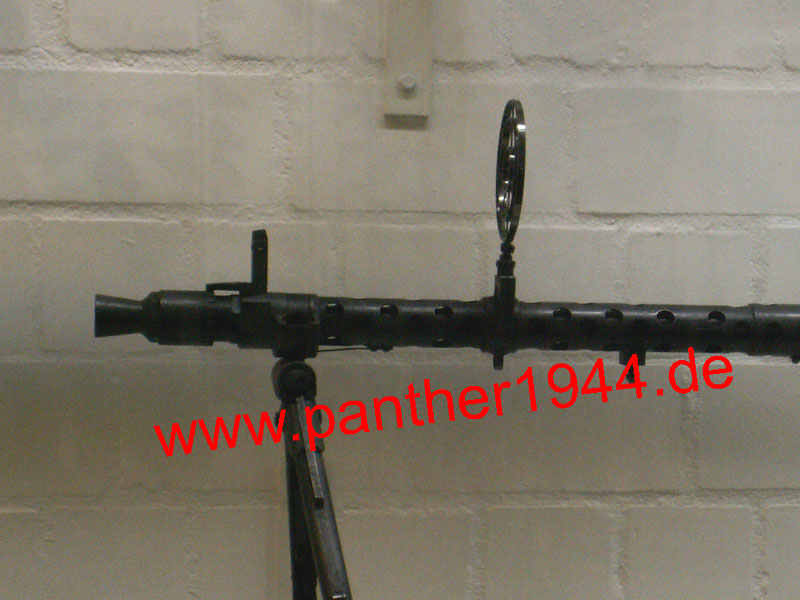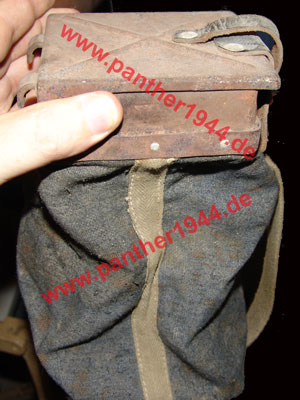Light machine gun MG 34, cal. 7,92 mm
One MG was installed in a ball mount in the glacies plate. This one was operated by the radio operator, using the KZF 2 (Kugelblendenzielfernrohr)weapon sight. During administrative movement or railway transport this MG was dismounted from the ball mount and used as anti-aircraft MG (Fliegerabwehr-MG; FlaMG) mounted on the “Fliegerbeschußgerät” at the commander's cupola.
One further MG was installed coaxial to the main gun in the gun mantlet and operated by the gunner.
Technical data |
|
|
calibre: |
7,92 mm |
|
ammunition feed: |
Metal ammunition belt, 50 rounds (belts could be connected) |
|
Vo: |
760-920 m/s |
|
firing rate: |
800-900 rounds per minute (R.P.M.) |
|
length of the weapon: |
1225 mm (1120mm for Modell 34/41) |
|
Barrel length: |
625 mm (560mm for Modell 34/41) |
|
weight: |
~12 kg |
|
weapon sight: |
V-notch, 200-2000 m |
|
effective range: |
on bipod 1200 m, as sMG/FzMG 3000 m, maximal 4570 m |
|
propulsion: |
recoil-operated |
|
cartridge: |
7,92 x 57 |
|
grooves: |
4/r |
|
Price: |
310,- RM |
|
Ammunition in stock: A and D |
5100 rounds in 34 bags (Gurtsäcke) |
|
Ammunition in stock: G |
4800 rounds in 32 bags |
|
Ammunition in stock: PzBefWg Panther Ausf. A and D |
5100 rounds in 34 bags |
|
Ammunition in stock: PzBefWg Panther Ausf.G |
4800 rounds in 32 bags |
Close defence weapon (Nahverteidigungswaffe)
|
Technical data |
|
|
calibre: |
92 mm |
|
ammunition feed: |
Einzellader |
|
The following cartridges could be fired off: |
|
|
Sectional drawing |
The similar weapon was mounted starting in 1943 in several AFVs used by the Wehrmacht Link to the Kapitel XVIII. Nahverteidigungswaffe summary from the manual „D 655/2 - Panther Ausf. A, D und G und Befehls-Panther Ausf. A, D und G - Gerätebeschreibung und Bedienungsanweisung zum Turm“ More information about ammunition and pictures can be found behind the link above-mentioned |
MP 40(sub machinegun)
(also known as Schmeißer-Fallschirmjäger-MP)

Technical data |
|
|
calibre: |
9 mm |
|
ammunition feed: |
32-round detachable box magazine |
|
Vo: |
380 m/s |
|
length: |
88,9 cm (stock extended) |
|
barrel length: |
248 mm |
|
weight: |
4,08 kg w/o magazine |
|
weapon sight: |
Hooded front blade, Stangenvisier bis 100 m; Klappvisier bis 200 m |
|
max. range (unerringly): |
ca. 200 m |
|
action: |
Straight blowback, open bolt |
|
cartridge: |
9x19mm Parabellum |
|
grooves: |
6/r |
|
cooling: |
air cooling |
|
firing rate: |
450-540 rounds per min |
|
selective fire: |
fully automatic fire |
|
price: |
60,- RM |
note: 1943 a version with double magazine was produced
The MP 40, development from the MP 38 , is one of the most famous German infantry weapons. Its popularity made it replace all other types of sub machineguns within the Wehrmacht and led to the fact, that it was issued to tank crews as well as regular infantry.
Walther P 38

Technical data |
|
|
calibre: |
9 mm |
|
ammunition feed: |
8-round detachable single-stack magazine |
|
Vo: |
317 - 357 m/s |
|
length: |
21,59 cm |
|
Barrel length: |
125 mm |
|
weight: |
964 grams |
|
weapon sight: |
Rear notch and front blade post |
|
effective range: |
Sights set for 25 m |
|
action: |
Short recoil, locked breech |
|
Cartridge: |
9x19mm Parabellum |
|
grooves: |
6/r |
|
selective fire: |
Single shot (double action) |
|
price: |
32,- RM |
|
data sheet
|
The "P 38", which replaced the Pistole 08, has some unusual technical characteristics. Unlike most semi-automatic pistols the hammer must not be prestressed to be fire ready. With the "Double Action" a pull of the trigger, with the hammer down, fired the first shot. So the P 38 could be carried safe even when it was loaded.
Walther PPK
(Polizei-Pistole, Kriminalmodell orauch kurz)

Most of this weaponds were optained private
Technical data |
|
|
calibre: |
7,65 mm |
|
ammunition feed: |
Magazin mit 7 Cartridgen |
|
length: |
15,24 cm |
|
weigth: |
525 grams |
|
cartridge: |
7,65 mm x 17 HR Browning |
|
action: |
Straight blowback |
|
selective fire: |
Single shot (double action) |
Signal pistol (Leuchtpistole)

Technical data |
|
|
Calibre: |
26,5 mm |
|
ammunition feed: |
Single loader, break action |
|
Stowed ammunition: |
24 rounds |
|
Many different variations of signal pistols were existing. I was not originally designed as warfare agent. Its use was to fire flares and signal ammunition. During world war II different types of explosives were developed for the pistol. In this context, we refer to the Nahverteidigungswaffe |
|
|
Sectional drawing |
The similar weapon was mounted starting in 1943 in several AFVs used by the Wehrmacht Link to the Kapitel XVIII. Nahverteidigungswaffe summary from the manual „D 655/2 - Panther Ausf. A, D und G und Befehls-Panther Ausf. A, D und G - Gerätebeschreibung und Bedienungsanweisung zum Turm“ More information about ammunition and pictures can be found behind the link above-mentioned |














